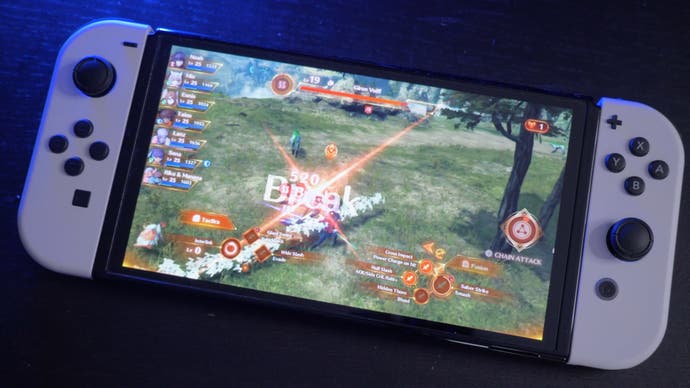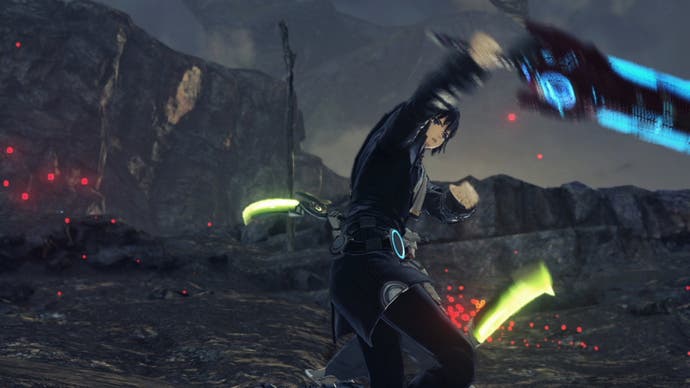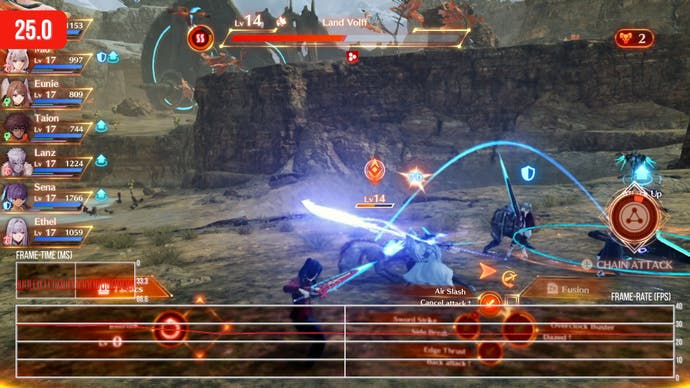Xenoblade Chronicles 3: how Monolith Soft pushes its Switch technology to the next level
Improved visuals, animation and image quality are just the tip of the iceberg.
Since its acquisition in 2007, Monolith Soft has become one of Nintendo's most prolific development partners thanks to both its assistance on first-party projects and, more importantly, its work on Xenoblade Chronicles. This large-scale RPG series has become one of Nintendo's key pillars in the RPG space and for good reason - its robust technical underpinnings, gorgeous vistas and strong storbytelling all work in tandem to create something unforgettable and Xenoblade Chronicles 3 is no exception.
With its fresh cast of characters, enhanced technology and outstanding soundtrack, Xenoblade Chronicles 3 builds on the experience the team has acquired since its inception and comprehensively addresses a key weakness of the last series entry: image quality. In targeting higher end visuals, something that to give, with resolution taking a big hit. Dynamic pixel counts that could hit 540p docked and 360p in mobile mode were mitigated via a relatively simple spatial upscaler, paired with intrusive sharpening. Xenoblade 3, however, represents a colossal leap forward in that respect. Monolith has both improved the overall visual quality while greatly boosting image quality, achieving this via what looks like a temporal super-resolution solution, taking those lower pixel counts up to a passable rendition of 1080p when docked and 720p in portable play.
The drawback to this solution is that with fast motion, visible break-up can occur revealing the lower resolution nature of the image but in most cases, image quality is perceptibly sharper than anything you'll see in Xenoblade Chronicles 2 - and the implementation is particularly impressive in portable mode, delivering one of the sharpest images from all the high-end titles we've seen on Switch - a far cry from the exceedingly blurry Xenoblade 2. Yes, the resolution slips to similarly low levels but what you see by eye is noticeably sharper, which is what matters.
The inclusion of this technique also raises questions regarding the upcoming sequel to The Legend of Zelda: Breath of the Wild - as far as we know, Monolith Soft has provided engineering assistance to Nintendo for this game and perhaps this explains why the most recent trailer exhibited such clean image quality, exceeding our expectations. Could it be that the solution employed for Xenoblade Chronicles 3 is also deployed in the next Zelda title? We'll have to wait and see. That said, this solution to anti-aliasing is not without flaw - look closely and you may spot subtle warping of the image during movement but, honestly, it remains a vastly superior approach to anti-aliasing next to any prior Xenoblade game especially for portable players.
Of course, there's more to this game than the quality of its presentation and I was also impressed by character and world rendering. Xenoblade 3 aims to mimic an anime style aesthetic while retaining depth inherent in three-dimensional rendering. Eye, hair and facial features are all presented using smart visual features to achieve the desired look. Eye rendering is an interesting showcase - head-on you'll see a typical 2D anime look, but looking in profile, it's clear that eyes are curved, flecks of lights reflecting on their surfaces. Character movement is improved too, with more realistically proportioned characters and inverse kinematic calculations ensuring that the position of feet adapts to the undulation in the ground, as opposed to clipping through it as seen sometimes in prior series entries. The animation also more closely matches camera speed eliminating that sensation of gliding above the world - an issue with the first Xenoblade game.
I was also impressed with cutscene animation. Xenoblade 2 was always impressive in this regard but the scope and scale of the sequences in this new game outshine anything Monolith had done in prior titles especially compared to the first entry in the series. While the typical dialogue sequences remain relatively simplistic, key story moments are depicted with stylishly directed sequences that predominantly play out in real-time. I was also impressed to see per-object motion blur in both cutscenes and gameplay - yes, it's a relatively low resolution with visible speckling and pixelation but it does a great job of accentuating fast animation.

Moving beyond the characters, environmental rendering is also generally of high-quality but with constraints. It's clear that we're looking at the latest iteration of the engine first built for Xenoblade X on Wii U - this new game exhibits many of the same design choices - but there have been improvements made along the way. The world is divided up into multiple regions divided up by loading screens but each of these regions is large in scale lending the game a seamless presentation. You can fast travel between areas you've already visited and it features a surprising amount of variety. You'll explore grassy plains, scorching deserts, dank caverns and more as you make your way through the game.
If we work our way down through the world composition, the first key element worth noting is the sky above which combines a beautifully textured sky dome with a procedural cloud system that changes based on weather conditions. These clouds are rendered at a lower resolution, quarter resolution if I had to venture a guess, but the soft nature ensures that the effect is convincing in most cases. Xenoblade 3 features a full time of day system like prior games but shadows are static and do not adjust based on sun position. This saves on performance, but the world feels slightly less dynamic than other large scale games - a compromise seen on prior series entries.
The world itself is beautifully depicted with long view distances, reasonably sharp texture work and beautiful art design but it's clear that many of the same limitations remain in effect from earlier Xenoblade games. LOD pop-in is a key aspect in rendering an open world environment. It's simply unfeasible or even desirable to display all objects at full detail when they only occupy a few pixels at a distance. However, smooth transitioning between lower detail and higher detail LODs is critical and Xenoblade 3 is mixed in this regard.

By and large, the terrain does manage to feel solid but you'll spot rock formations, trees and fields of grass popping into view during exploration, yet I still think they're done a better job managing this compared to the last couple games. It's less jarring overall -In Xenoblade Definitive Edition, for instance, there is a stark line between where foliage is drawn and where it is not - this line remains in Xenoblade 3 but the effect is more gradual with sparse foliage presented along the outer edge smoothly integrating with the thicker fields near the player.
Despite these criticisms I feel the world is a sight to behold - Monolith continues to excel in its very specific niche - that is, crafting large open world environments that are gorgeous to explore yet able to run on lower powered gaming platforms. These flaws would be less forgivable on a more powerful box but given the limitations of the Switch, the studio has done remarkable work here.
Performance is mostly fine, but far from flawless. By default, Xenoblade Chronicles 3 aims to deliver a frame-rate capped at 30 frames per second, much like prior entries. It features correct frame pacing and appears smooth when operating at its peak. That said, while playing the game I found that performance varies based on the complexity of the environment and the size of encounters. Typically, simple environments stick to the target performance level, even when returning with a larger party from later in the game.

However, as I made progress, certain areas seemed to incur a greater hit to performance which becomes most evident during combat. This may be due to the large number of visible party members participating in the battle combined with the environmental complexity but either way, the impact to fluidity is palpable. Whether this is an issue for you will depend on your tolerance for performance hiccups - this has minimal impact on the actual gameplay given the nature of its menu and shortcut driven design, but it can be distracting for many users.
On the audio side, I'm impressed with Monolith Soft's efforts. Sounds is always hit or miss on the Switch with many games offering nothing more than 2.0 stereo output when docked but I'm happy to report that Xenoblade 3 does, in fact, support full 5.1 surround sound. The rear channels receive plenty of use and the game's soundscape is fantastic. It also includes both English and Japanese language options to suit different preferences, but it's the musical score that really seals the deal. Featuring a selection of musicians including the always delightful Yasunori Mitsuda, Xenoblade Chronicles 3 boasts a wide selection of tracks that really pull you into the game.
Between the presentation, music, storytelling and gameplay refinements, Xenoblade Chronicles 3 really got its hooks into me and it's well on its way to becoming my favourite entry in the series. The only real complaint I could level at it is the prevalence of tutorials during the first dozen hours or so - it's not as continuous as Xenoblade 2 but I'm still not a huge fan of this inclusion. Still, given the quality of this title across the board in terms of gameplay, technology and presentation, Xenoblade Chronicles 3 is highly recommended.





.png?width=291&height=164&fit=crop&quality=80&format=jpg&auto=webp)
.jpg?width=291&height=164&fit=crop&quality=80&format=jpg&auto=webp)



